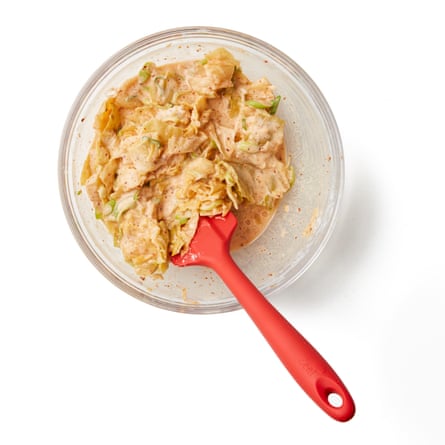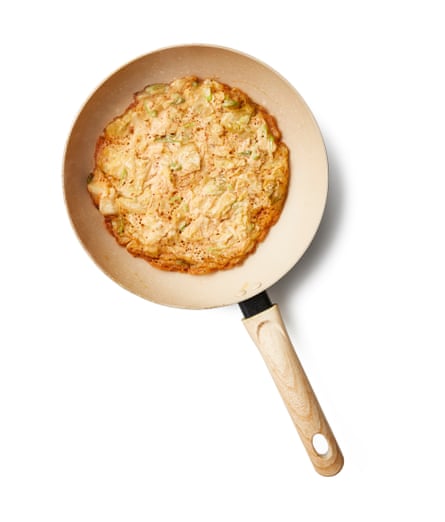
Crepes, okonomiyaki, blini, dosa … much as I love a classic pancake doused in sharp lemon juice and crunchy sugar, they’re certainly not the only option for those celebrating Shrove Tuesday. Every culinary culture has its own take, but the Koreans are particularly rich in recipes, the most famous of which is probably kimchijeon, or buchimgae, which are flavoured with spicy fermented vegetables – YouTube sensation Maangchi describes it as “one of Koreans’ all time favourite dishes … On a rainy day on the weekend, when a Korean family wants something special and cozy to eat, this is something anyone can make using the ingredients we have at home. Then mom will ask: ‘You want me to make kimchijeon?’ and everybody will say: ‘Yayyy!!’” Which is, of course, the appropriate response when someone offers you a hot, crunchy, salty, spicy snack with a side helping of probiotic smugness. If you also lack a Korean mom, don’t worry – I’m here to help.
The dry materials
You can make a perfectly decent Korean pancake with ordinary plain flour of the sort that sells for less than £1 a kilo – Maangchi herself recommends it, as does chef Kisu of Korean street food stall Ssambop, whose recipe is collected in Dina Begum’s Brick Lane Cookbook. Aaron Huh of Korean social media duo Aaron and Claire prefers Korean pancake mix, but allows that, if you can’t get hold of it, you can use plain flour instead – on examining the labels at my local Korean supermarket, I discover this pancake mix tends to contain flour, cornflour and baking powder, as well as various seasonings, so I follow a recipe by Hyosun of the Korean Bapsang blog to make my own. I also try a batter recipe by chef Hooni Kim, which uses plain and corn flours (a combination also favoured by J Kenji López-Alt), and baking powder for spring onion pancakes, and one from the Crazy Korean Cooking site, which mixes plain and glutinous rice flours, saying, “if you don’t have it, just add more flour. But it’s really good if you do add it.”
Using a proportion of lower-protein flour, such as rice, potato or corn-, is wise to limit gluten development (which, though useful for keeping the pancake together, will also make it tough) and to stop it absorbing so much moisture and oil in the pan (which will leave it soggy and greasy). I love the slight bounciness that the glutinous, or sweet rice flour gives the batter – making it “extra-crispy outside and deliciously chewy inside”, as the Crazy Korean Cooking host puts it – but if you have only the ordinary sort, or indeed cornflour or another sort of starch, by all means use that instead. A little baking powder, though not mandatory, will create bubbles in the batter, which will make it even lighter and crisper.
The liquid element
These are pancakes made with water, rather than milk, but also, in the tastiest examples, kimchi brine. Kim’s suggestion of sparkling water “to lighten up the batter with carbonation” and prevent “the pancakes from becoming too dense” is a good one, but even if you use tap water, make sure it’s as cold as possible, because low temperatures also inhibit gluten development (Kim puts his in the freezer for 10 minutes before use, but I didn’t find this made enough of a difference to make up for the hassle of finding space. If you have a more capacious freezer than mine, however, you might want to give this a go; at his New York restaurant, Kim informs readers of his book My Korea, they keep the batter in the freezer throughout service).
Kim also puts an egg yolk in his batter, while chefs Judy Joo and Sohui Kim add a whole egg in their respective books, Korean Made Simple and Korean Home Cooking. Though I’m aware that, in theory, the whole point of Shrove Tuesday is to use up such things before Lent, I’m going to leave egg out of my, because, in amateur hands, they can make the batter heavy, which is exactly what I’m hoping to avoid here. All kimchi pancakes are good, but some are a lot better than others.
The vegetables
Bring whatever kimchi you like to this party, though kimchijeon is often recommended as a good way to use stuff that has become a little too intense to eat on its own – as Joo puts it, “when your kimchi gets really funky and fermented, and you’re scared of what it might do to your digestive system, that’s the best time to make these pancakes. That’s when the kimchi flavour really shines through.” And if your kimchi is a young, milder example, Aaron even recommends doctoring the it with a little vinegar. And make sure you chop the kimchi, if necessary, otherwise your pancakes are likely to be unwieldy.
Onions are the other common ingredient: Ssambop and López-Alt both use ordinary yellow onions, chopped or sliced, but I prefer the greener, fresher flavour of spring onions. You could also add other chopped vegetables, or indeed minced pork or prawns, or cubes of tofu, though kimchi ought to remain the dominant flavour.
The flavourings
Salt and sugar pop up in every recipe I try, though if you’re averse, by all means do leave out the sugar (and, indeed, the salt). Kim adds doenjang, or fermented soya bean paste, and garlic to his scallion pancake batter, and Hyosun puts garlic powder in her homemade pancake mixture, but my favourite seasonings are the gochugaru chilli powder deployed in the Crazy Korean Cooking video, Kim and Aaron’s recipes, as well as Aaron’s MSG. Yes, MSG. This is very much optional, because I’m aware some people find the very mention of it offensive, but it does give the pancakes an addictively savoury quality – as Aaron notes, with its help, “people will say you should open a restaurant”. If you don’t have any, or don’t want any, you could try using a crumbled stock cube (Aaron recommends Korean beef stock powder), or trust in the kimchi alone.
The cooking
Otherwise known as the single most important step in this whole process. Aaron is clear: “Kimchi pancake is all about the crispiness.” And that crispiness requires oil, in quantity, as he explains: “To make it more delicious, you need a good amount of oil, and this is why it tastes always better at traditional markets – they almost, like, deep fry it.” Some recipes are shy about this fact, and pretend that you can get good results with just a teaspoon of oil. They are lying to you. The results will taste good, because, as previously noted, all kimchijeon are good kimchijeon, but the texture will be soft and flabby, rather than shatteringly crisp.
Don’t add all the oil to the pan at once, though, because you’ll make life harder for yourself when it comes to turning the pancakes – instead, do as Maangchi tells you, and save half for when you flip them, thus ensuring both sides are crisp, and reducing the chances of you ending up with minor burns. She says that when she put out her first video on the subject, “The number one question was: ‘How come my pancake isn’t crispy in the middle?’ And that’s because you need to use a generous amount of oil, and make sure it gets under the pancake” by tilting the pan while lifting the pancake itself.
Most recipes make one large pancake, which are perfect for cutting into wedges to share like a pizza, but I’ll admit that I find it tricky to toss neatly, so I prefer to make two smaller ones. However, if you’re braver, cook the mixture all at once.
The sauce
Some recipes suggest serving the pancake with a sauce, often using a combination of soy sauce, rice vinegar and sesame oil, with Joo adding chilli flakes, spring onions and crushed roasted sesame seeds, Hooni Kim garlic and ginger, and Sohui Kim honey. I don’t think you need one, given the pancake itself has enough flavour to see you through to Easter, but feel free to play around with your own combinations – though Crazy Korean Cooking simply instructs viewers to “pair with makgeolli”, or korean rice wine, which is a serving suggestion I’m also happy to endorse.
Perfect kimchi pancakes
Prep 5 min
Cook 8 min
Makes 1 large or 2 small ones
200g chopped cabbage kimchi
2 spring onions, trimmed and chopped
40g plain flour
40g glutinous rice flour (or see above for other options)
½ tsp baking powder
½ tsp MSG powder, or stock powder (optional)
¼ tsp salt (optional)
½ tsp sugar (optional)
½ tsp Korean chilli flakes (optional)
60ml kimchi juice
120ml cold fizzy water
Neutral oil, for frying
Put the kimchi in a large bowl and cut up any remaining large pieces (scissors are useful here).
Add the spring onions, flours, baking powder, MSG, salt, sugar and chilli flakes, if using, then stir in the kimchi juice and the water, and mix briefly and only until you can see no more dry ingredients; if you overmix, your pancake will be tough.

Put two tablespoons of oil in a large, nonstick frying pan on a medium-high heat and wait until it shimmers. Spoon in half or all of the batter, depending on whether you’re making one large or two small pancakes, and flatten into a thin round.

Move the pancake around by shaking the pan as soon as you’re able to, to help spread the oil underneath and stop the pancake sticking, then leave to cook for about five minutes, until the edges are golden brown and the top is matt (go by the look of it).
Carefully flip it over, by using a spatula or a plate, or by tossing the pancake if your level of confidence is high, then lift it slightly and tilt the pan again to move the oil about underneath it – add more if there isn’t much left in the pan.

Cook for another three or so minutes, until golden and crisp (repeat with the remaining batter, if making two smaller pancakes). Slide on to a board or plate, cut into wedges and eat immediately.
-
Are kimchijeon your favourite variety of Korean pancake, or would you like to argue the case for seafood, spring onion, potato or another version? And which other pancakes will you be eating this year?



